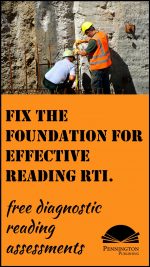Mastery Learning in RtI
I just finished watching a TED TALK by Sal Khan, founder of the Khan Academy. Sal was talking about mastery learning and the importance of building strong learning foundations before layering on additional information.
As I watched the video, I was thinking about why a stubborn 25% of most students in the upper elementary, middle, and high schools are reading two or more years below grade level.
Sal cites the example of a child who scores an average grade of 75% on a unit test. Most educators would accept 75% as an average score, and in fact most diagnostic assessments would accept 75—80% as mastery level; however, Sal points out the not knowing 25% of the test components is problematic. From the student’s perspective: “I didn’t know 25% of the foundational thing, and now I’m being pushed to the more advanced thing.”
When students try to learn something new that builds upon these shaky foundations, “they hit a wall… and “become disengaged.”
Sal likens the lack of mastery learning to shoddy home construction. What potential homeowner would be happy to buy a new home that has only 75% of its foundation completed (a C), or even 95% (an A)?
Of course, Sal is a math guy and math lends itself to sequential mastery learning more so than does my field of English-language arts and reading intervention. My content area tends to have a mix of sequential and cyclical teaching learning, as reflected in the structure of the Common Core State Standards. The author of the School Improvement Network site puts it nicely:
Many teachers view their work from a lens that acknowledges the cyclical nature of teaching and learning. This teaching and learning cycle guides the definition of learning targets, the design of instructional delivery, the creation and administration of assessments and the selection of targeted interventions in response to individual student needs.
At this point, our article begins to beg the question: What if a shaky foundation is what we’re dealing with now? We can’t do anything about the past. Teachers can start playing the blame game and complain that we’re stuck teaching reading to students who missed key foundational components, such as phonics. All-too-often, response to intervention teachers are ignoring shaky foundations and are trying to layer on survival skills without fixing the real problems.
Instead, teachers should re-build the foundation. Teachers can figure out what is missing in the individual student skill-sets and fill the gaps… this time with mastery learning.
*****

The Science of Reading Intervention Program
The Science of Reading Intervention Program: Word Recognition includes explicit, scripted, sounds to print instruction and practice with the 5 Daily Google Slide Activities every grades 4-adult reading intervention student needs: 1. Phonemic Awareness and Morphology 2. Blending, Segmenting, and Spelling 3. Sounds and Spellings (including handwriting) 4. Heart Words Practice 5. Sam and Friends Phonics Books (decodables). Plus, digital and printable sound wall cards, speech articulation songs, sounds to print games, and morphology walls. Print versions are available for all activities. First Half of the Year Program (55 minutes-per-day, 18 weeks)
The Science of Reading Intervention Program: Language Comprehension resources are designed for students who have completed the word recognition program or have demonstrated basic mastery of the alphabetic code and can read with some degree of fluency. The program features the 5 Weekly Language Comprehension Activities: 1. Background Knowledge Mentor Texts 2. Academic Language, Greek and Latin Morphology, Figures of Speech, Connotations, Multiple Meaning Words 3. Syntax in Reading 4. Reading Comprehension Strategies 5. Literacy Knowledge (Narrative and Expository). Second Half of the Year Program (30 minutes-per-day, 18 weeks)
The Science of Reading Intervention Program: Assessment-based Instruction provides diagnostically-based “second chance” instructional resources. The program includes 13 comprehensive assessments and matching instructional resources to fill in the yet-to-be-mastered gaps in phonemic awareness, alphabetic awareness, phonics, fluency (with YouTube modeled readings), Heart Words and Phonics Games, spelling patterns, grammar, usage, and mechanics, syllabication and morphology, executive function shills. Second Half of the Year Program (25 minutes-per-day, 18 weeks)
The Science of Reading Intervention Program BUNDLE includes all 3 program components for the comprehensive, state-of-the-art (and science) grades 4-adult full-year program. Scripted, easy-to-teach, no prep, no need for time-consuming (albeit valuable) LETRS training or O-G certification… Learn as you teach and get results NOW for your students. Print to speech with plenty of speech to print instructional components.
Click the SCIENCE OF READING INTERVENTION PROGRAM RESOURCES for detailed program description, sample lessons, and video overviews. Click the links to get these ready-to-use resources, developed by a teacher (Mark Pennington, MA reading specialist) for teachers and their students.
Get the SCRIP Comprehension Cues FREE Resource:
![]()
Get the Diagnostic ELA and Reading Assessments FREE Resource:![]()
*****
